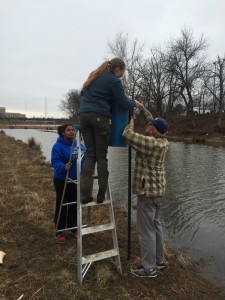The theme for the 2018 Society for Freshwater Science meeting in Detroit, MI was “navigating boundaries in freshwater science”. A strong contingent of STRIVE lab members presented research that fit well within this theme, ranging from nutrient dynamics in linked reservoir-stream systems (K. Stefanik, R. Czaja), ecological networks (T. Kenly), upstream-downstream connections driven by aquatic insect drift (L. Rieck), urbanization effects on fish (L. Bajakian), cross-boundary effects of invasive species (K. Diesburg), and water quality and aerial insectivorous birds (J. Corra, D. Manning). Congrats to all for a successful and productive meeting! Check out the STRIVE lab twitter feed for action photos and more!
Speaking of navigating boundaries – we are continuing to learn more about the 5th Ave dam removal and how the Olentangy River ecosystem is responding to the removal of this conspicuous upstream-downstream boundary. Our work (and several other dam-removal studies) has previously focused on the importance of restoring upstream-downstream connections within the stream channel (see our blog post from last year, as well as recent article by Cook and Sullivan, below). But, we wanted to know more about how removing the dam could have effects that cross from the river to the riparian zones directly adjacent to the stream channel. To figure this out, we measured a few key responses: one was the number and biomass of aquatic insects that emerged from the river, and another was the spiders and birds (tree swallows) that live near the river and rely on aquatic insects for food. We also measured the chemical signatures (stable isotopes) of the algae and detritus in the river, the emergent insects, and spiders and swallows; these signatures allowed us to piece together the diets of spiders and swallows to understand how much of their food comes from the river, vs. terrestrial sources.

An orb-weaving spider of the family Tetragnathidae. These spiders often live in the margins of rivers, eating emerging aquatic insects. After dam removal, we observed a nearly 10-fold decline in their densities adjacent to the river. Photo: A. Kautza
So what happened to the river after dam removal that crossed aquatic-terrestrial boundaries? Well, mostly we found that the contraction of the river channel, and loss of vegetation at the edge of the river channel was bad news for the spiders (pictured left) – we saw close to a 10-fold decline in spider densities after the dam was removed, particularly where there was extensive floodplain restoration (pictured below).
The other responses we measured were less clear. By and large, spider and swallow diets were unchanged post-dam removal, and the variation we did observe was explained more by regional factors like annual temperatures, precipitation, and the river’s discharge. Nevertheless, we think that navigating across boundaries in this way could be an important aspect of future dam-removal monitoring and restoration efforts, particularly for larger dam-removal projects that prompt drastic changes to river morphology, and functioning.

Looking upstream toward Lane Avenue during extensive riparian restoration of the Olentangy River a few months after dam removal. Photo: SMP Sullivan
For more information, you can read the paper (open access) online:
Sullivan, S. M. P., D. W. P. Manning, and R. P. Davis. 2018. Do the ecological effects of dam removal extend across the aquatic-terrestrial boundary? Ecosphere 9(4):e02180 DOI:10.1002/ecs2.2180.
On the topic of dam removal, also check out another recent paper (also open access) from STRIVE on the ecological effects of dam removal:
Cook, D.R., and S.M.P. Sullivan. 2018. Associations between riffle development and benthic macroinvertebrate and fish assemblages following lowhead dam removal. Environmental Monitoring and Assessment 190: 339.







